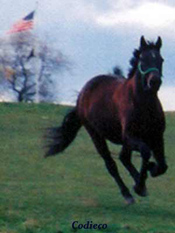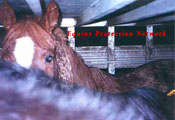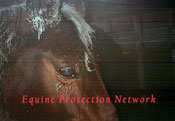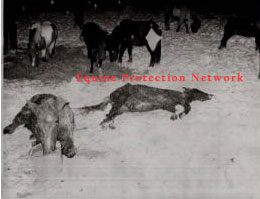
Shop for CD's at CDRush.com & the EPN Benefits!
Put "EPN" in the Coupon Code box when you place your order.
Now you can save money on your favorite music and help the horses at the same time!
EPN Website Sections
Press Stories 1980-2004
Caution Horses For Slaughter
by Heather Chapin-Fowler of the Corral Staff
The Final Roundup
Pittsburgh Magazine
5 /2004
Fighting to Stop the Sale
& Slaughter of US Horses
in Foreign Countries -
KDKA TV Investigates
4/30/2004
The Slaughter Question
Horse & Rider 12/2002
State Ranks High in
Equine Slaughter
WTAE's Paul Van Osdol
Reports 4/27/2001
Slaughterhouse Ride
WISH TV News 8 I-Team
Investigative Report 4/2001
Illinois Defeats Horse
Slaughterhouse!
1999
Kill Sale
Pittsburgh Post Gazette
6/ 1999
Horses To Slaughter
Police, vet check horses
' health at New Holland sale
July 1998
PA Horse Transport Legislation
Act 64 of 2001
Horse Transport Bill Passes
Unanimously
WTAE's Paul Van Osdol Reports
6/21/2001
State Lawmakers Urged
to Protect Horses en route
to Slaughterhouses
June 1998
State Concerned with
Cruelty to Horses
Taken for Slaughter
'TRAIL OF TORTURE' ?
June 1998
Horse-Slaughter Industry
Critics Pushing Changes
PA. Bill Would Help
Protect Horses Headed to Slaughter
March 28, 1998
The goal is a humane trip
for horses on the way to be
killed for their meat, prized in Europe.
New York Does PA's Dirty Work
January 1998
NYSP Stop Double Deck Trailer

Horses inside double deck
cattle trailer stopped by the
NYSP. The owner was later
convicted & fined $3000.00.
Horse Popsicle Case
1994
Cruel Transport Result
s in $11,100 Fine

Horses inside double
decker covered with frost.
The Last Ride
Eyewitness Account of trip
to Slaughterhouse
Overcrowding, negligence
plague Shelby horse feedlot
Great Falls Tribune 8/10/2003
The Torture Trail
December 1980
85 horses in trailer, 57 survive

A dead horse lies in the snow,
while another too weak to
rise eats from a bucket.
The Miracle Mile
July 1990
Pregnant Mare Foals Hours
After Rescue From Slaughterhouse-
Foal is a Stakes Winner!

Pasturemate of the Stakes Winner,
"On Route 66" who was born only
hours after her dam was taken from a slaughterhouse
PA Dealer Sent to Prison
1999
Shady Horse Dealing
Renaissance Bob
12/ 1998
Rescue of a Racehorse

An Eye For An Eye
Story of Catch-22
Links
California Voters "Just Say Neigh" to Horse Slaughter!
HoofPAC
Shop online at IGive.com with over 600 great stores you know & love- including Back In the Saddle! Up to 26% of the purchase price is donated to the EPN!
The EPN gets $5 extra the first time you shop!
PayPal accepts credit cards! Please send your tax deductible donation to the:Equine Protection Network, Inc.,
P. O. Box 232, Friedensburg, PA, 17933.
HoofPAC is the political action committee that has been formed to end the slaughter of America's horses. Cathleen Doyle, founder of HoofPAC, led the successful Save The Horses campaign in 1998 that made the slaughter of California's horses a felony.
"The price of euthanasia and rendering, at its highest, is equivalent to a few shoeing's, If we can afford to shoe our horses so they can serve us, we can afford to give them a humane and dignified death."...
Cathleen Doyle, HoofPAC
Page last revised on:

Special Report: The Slaughter Question
Thank you to Horse & Rider for covering this story and allowing the EPN to reproduce The Slaughter Question on our website.
Horse & Rider, December 2002, Jennifer Corkery,
Editor's note: As we were preparing this article for publication, the remaining two equine slaughterhouses in the country, both located in Texas, came under fire. (See "Last U.S. Slaughter Plants to Close?" on page 54.) No one knows what the outcome of that battle will be, but our special report will bring you up to speed on the complexities of this important, difficult issue. For updates, check equisearch.com, and future issues of H&R.
Jeanette's new gelding, Bart, just wasn't working out. His classified ad had touted him as an "awesome athlete" that would be great for an "intermediate rider." After she'd had him a short while, she discovered he used his athleticism mainly to rear and buck at unpredictable moments. Unable to sell the gelding at private treaty -- because she refused to misrepresent him -- she opted in frustration to send him to a local livestock auction. She'd heard stories from friends who'd found riding horses there. Maybe the right person would find Bart, she reasoned, someone with the skills and patience needed to transform him into a reliable mount.
With that happy ending fixed in her mind, Jeanette shrugged off a few misgivings as she handed Bart over to auction-yard workers. the next morning, alas, nobody fitting Jeanette's daydreams found her gelding at auction. For $750, though, a man who knows how to turn a profit from horseflesh did. That afternoon, Bart was loaded onto a cramped double-decker trailer and hauled across six states to meet his end in a slaughterhouse.
Bart's story couldn't have taken place in California. Since the passage of Proposition 6 in 1998, the sale and transport of horses for slaughter have been banned in that state. Now, slaughter opponents are zeroing in on the last two equine slaughterhouses in the United States, hoping a little-used state law will close down the foreign-owned Texas plants for good.
On the other side of the issue, slaughter proponents -- which include many who earn their living in the horse industry, and groups such as the American Quarter Horse Association -- view banning slaughter outright as folly that will lead to tragic, unintended consequences.
The key point of contention is whether horses should be slaughtered at all -- that is, whether slaughter is, or can be regulated to be, a suitable alternative for unwanted horses. Within that issue arise other arguments over the treatment and circumstances of horses before and during transport, as well as their treatment and method of death once at the slaughter plant. Further disagreement swirls around the fate of unwanted horses should slaughter be banned.
In this article, we'll look at both sides of the arguments surrounding this highly charged issue.
Slaughter in America, Dinner Abroad
The term "slaughter" applies to the method of procuring meat for human consumption. By law, the slaughter animal is kept alive until it can be immediately processed for food. The method of death must not introduce foreign substances into the animal's body; therefore, no euthanasia drugs may be used. Instead, the animals receive a stunning shot to the brain, then are immediately bled out (exsanguinated) and dismembered.
This procedure differs dramatically from rendering, in which the carcass of an already-dead animal is processed into byproducts, such as bone and blood meal for animal feed and fertilizer, steric acid for car tires, and tallow for soaps. It's permissible for horses arriving at rendering plants to be dead from disease, natural causes, or euthanasia drugs, because the intense heat in the vats breaks down any potential contaminants, disease-causing organisms, chemicals, and pharmaceuticals.
Despite Americans' passion for beef, pork, and chicken, we don't eat horsemeat. It's the foreign market that drives the American horse-slaughter industry. Belgium, France, and Switzerland are the leading horsemeat consumers. And, with recent mad-cow and foot-and-mouth disease outbreaks, Europeans have increased their demand for horsemeat, both domestic and imported. (Other countries exporting horsemeat to Europe and Asia include our neighbors, Canada and Mexico, as well as Argentina, Australia, and New Zealand).
Largely as a result of this demand, approximately 70,000 U.S. horses are slaughtered or exported across the borders to slaughter in Canada or Mexico each year. This accounts for about 1 percent of the nearly 7 million horses in America. Horse slaughter was at its height in the late 1980s, when animals were sold off in great numbers after tax shelters for horse farms collapsed. According to United States Department of Agriculture figures, about 400,000 horses were slaughtered in the United States or shipped to Canada for slaughter in 1990. Today's figure is less than a sixth of that number.
Another marked decline is in the numbers of U.S. plants processing horsemeat. A decade ago, more than a dozen existed. Now there are just two Texas plants, whose futures are increasingly uncertain.
The Road to Slaughter
Unsound, unhealthy, unmanageable -- ultimately unwanted -- horses wind up in the slaughterhouse. Every breed and type can be found, from failed or broken-down racehorses and former pleasure and show mounts to unproductive breeding stock and by-product foals of the Premarin industry (which uses pregnant mares' urine to produce hormone-replacement drugs for women).
Christine Berry of the Equine Protection Network uses a Black Beauty analogy to explain how a horse can decline into unwanted status. Beauty starts out as a young, vital, well-bred horse who's sold from owner to owner, acquiring injuries and infirmities along the way. Less useful as a riding or working horse with each owner, he eventually finds himself up for auction as an aged, unsound gelding -- after a lifetime of loyal service. The story ends happily when Joe Green, a kind man who remembers Beauty from the days of their youth, buys the horse and retires him to pasture.
"But there are no Joe Greens for most horses sent to slaughter," laments Berry. The most common routes to the slaughterhouse for American horses are auctions and, to a lesser degree, private-party transactions and theft. Horses are sent to local auction (usually weekly or monthly livestock sales, as opposed to well-promoted, seasonal breed or performance-horse auctions) for a variety of reasons, and it's not always the aged and infirm that wind up in the slaughterhouse. Any horse that brings less than $1,000 (his per-pound worth) at auction is at risk of heading to slaughter.
"Killer buyers" -- those seeking a profit by buying and selling horses for the slaughter industry -- load up their purchases and haul them to Texas. The cheaper the horse, the more profit to be cleared. Thus, free horses, even those intended for good homes by naive owners, are particularly good deals for the killer buyers.
Slaughter opponents cite the path to slaughter, including auctions and transportation, as an industry segment that will continue to subject horses to misery despite the Commercial Transportation of Equine to Slaughter Act passed by Congress in 1996. Auction yards, with crowded pens of frightened, starving, injured, and frail horses, and the transport of those horses from auction to slaughterhouse, sometimes for days at a time in rigs unsuited for hauling horses, are a large part of the horse world's concern over the slaughter industry.
Double-decker big-rig trailers designed for shorter livestock, such as cattle and hogs, don't allow horses to stand comfortably or safely. Forty-plus horses can be squeezed in, after either climbing a ramp to the top deck or scrambling down a ramp into the belly. Once inside, many can't raise their heads due to the minimal 5-foot-8-inch clearance. New injuries are sustained as horses struggle to balance on metal floors slippery with urine and manure.
Extreme summer and winter temperatures compound the misery. Some horses show up at the slaughter plants dead on arrival, having succumbed to their preexisting conditions, or having been crushed and trampled.
"The economics of shipping horses to slaughter are in direct opposition to appropriate shipping methods," says Berry, who rode with and cared for valuable horses as an employee of one of the nation's largest commercial horse transporters. "To make it economical, too many horses are crowded into each shipment. All kinds of horses -- aggressive stallions, pregnant mares, yearlings, elderly geldings -- are forced in together, no matter their condition. To the slaughter industry, they're all the same. Many are in poor health or suffer severe unsoundness prior to the journey, so the ordeal is even more miserable for them. I've witnessed all of these horrors, and regulations haven't changed things."
On the other hand, Temple Grandin, one of the nation's leading authorities on the humane treatment of livestock, says transport to slaughter is not the horse's primary cause of suffering. "Some horses do get hurt on trucks," she stated in a September article by Barry Shlachter in the Dallas/Fort Worth Star-Telgram. "But the biggest problem is owner neglect -- long before the horse gets to a slaughterhouse."
Still, the Equine Protection Network opposed the Commercial Transportation of Equine to Slaughter Act, because of weak language and perceived shortcomings. Berry claims the act has, by not specifically outlawing them, actually helped entrench cruel practices, such as traveling for up to 28 hours at a stretch without resting, watering, or feeding the animals.
Double-decker trailers still legally transport horses to slaughter in every state except Arizona, California, Connecticut, New York, Pennsylvania, Virginia, and Vermont.
Inside the Slaughter Plant
Once at the facility, horses are driven into chutes, then shot in the skull with a captive dead bolt (a 4-inch nail that punctures the brain and then retracts). Each animal is then hung from the ceiling by a chain fastened to one hind leg, so that the carotid arteries and jugular vein at the base of the neck can be slit for bleeding out (even though the animal is unconscious, its heart continues to pump blood). Finally, the exsanguinated carcass is skinned, gutted, and dismembered.
Slaughter proponents say the process is essentially humane -- the horses don't know how they're going to be killed, and aren't subjected to physical pain. Opponents strongly disagree, pointing to the sensitive nature of horses, the particulars of the ordeal, and inadequate oversight in the plants.
They note that horses arriving at the slaughterhouse are exhausted from traveling for hours or days packed skin-to-skin with each other. Workers wielding prods then urge the animals through a system of chutes to the "knock box." There, the horses stand for the captive bolt. Naturally attuned to their surroundings, the horses can hear and smell what's going on around them.
The captive bolt is supposed to render horses unconscious and insensitive to their ensuing bleed-out and dismemberment.
"The captive bolt system is commonly misrepresented as an inhumane method of euthanasia," says Jerry Black, DVM, president of the American Association of Equine Practitioners. "It's a penetrating rod and the effect is the same as a bullet -- it renders the horse immediately brain dead. The effect is instantaneous and humane. Horses that are euthanized by a veterinarian don't even go that quickly."
However, that's another point of disagreement, because sometimes one shot with the captive bolt isn't enough to do the job.
Cathleen Doyle of Save the Horses and co-sponsor of California's Prop. 6, has undercover videotape of horses that must be hit two and three times by the device before finally going down, and they struggle frantically between shots. Also caught on film is a buckskin horse receiving a captive bolt shot to the shoulder to bring his head into position for the kill.
"The proof is in the pictures," Doyle says. "Pictures the pro slaughter forces are sure 99 percent of horse people will never see. I have footage of slaughter horses suffering violent, prolonged deaths, and couldn't get them on television to promote Prop. 6 because the stations told me, 'We can't show that. People would go crazy if they saw it.' Well, that's the point! Slaughter is ugly and violent, and it's been a hidden industry to all but the few who work in it."
Doyle contends that some horses aren't even brain dead when they're dumped out of the knock box, and that chaining and dismemberment begins while they're still conscious.
"Slaughter proponents say USDA officials at the plants ensure that slaughter is carried out in a humane manner. But those officials are meat inspectors in rubber boots and gloves, not experts with horses or their care. A slaughterhouse death is the furthest thing from humane euthanasia."
A Necessary Evil?
The horse industry is increasingly split on the issue. Most of the major breed organizations take no official stance. "We have no position statement," says Jerry Circelli, director of public relations and communications for the American Paint Horse Association, reflecting a common response, "We respect our members' individual decisions on this issue."
By contrast, the AQHA has made its pro-slaughter position public. The association claims that "the processing of horses for food" is a necessary facet of today's horse industry. It further maintains that if slaughter were banned, horses that would've been slaughtered will instead suffer a lingering death because of neglect and abuse by owners who no longer want or can afford them.
The AQHA also cites federal regulations intended to prevent slaughtered horses from suffering. "As with all livestock, the processing of horses has been fully regulated by the USDA for many years under the Humane Methods of Slaughter Act," states the association's position paper. "This requires USDA veterinarians and inspectors to review the plants and their methods to ensure they are following the requisite procedures."
The AAEP shares this stance. According to its official position statement of May 2002, the association "recognizes that the processing of unwanted horses is currently a necessary aspect of the equine industry, and provides a humane alternative to allowing the horse to continue a life of discomfort and pain, and possibly inadequate care or abandonment."
AAEP President Dr. Black adds, "If slaughter exists, we expect and advocate that it's done humanely and with dignity. We feel that with current federal guidelines for transportation and slaughter, horses are treated humanely. Within the last few months, our officers have conducted site inspections of the processing plants, and found those guidelines are being used regularly. The chairman of our welfare committee reported that the horses were treated very well, and there was nothing to indicate that wasn't the case on a regular basis."
Alternatives to Slaughter
What are the alternatives to slaughter for unwanted horses? Horse rescue groups can provide new homes for some horses, but many older, infirm animals will still need to be put down.
"The only proper, ethical way to end a horse's life if humane euthanasia at the hands of a veterinarian," says Berry, who concedes that this option is difficult for many owners. "Unfortunately, too many people won't take the responsibility for having a horse euthanized, preferring to pass it off at auction or give it away, hoping it'll go to a good home. But their horse would be far better off if they'd just summon the strength to have a vet put it down."
Another limiting factor is the cost of veterinary euthanasia, which varies throughout the country and from vet to vet. The actual procedure usually ranges from $75 to $150; carcass disposal costs can be another $100 to $250. (Recent energy price hikes have caused rendering plants to double and triple their charges for accepting carcasses).
"The price of euthanasia and rendering, at its highest, is equivalent to a few shoeing's," notes Doyle. "If we can afford to shoe our horses so they can serve us, we can afford to give them a humane and dignified death."
Veterinary euthanasia makes use of the anesthetic agent sodium pentobarbital. The time from injection to actual death varies.
"I tell people that their horse's eyes will typically glaze over while he's still standing, and at that point, he's pretty anesthetized, thus unaware," says equine-practitioner Barb Crabbe, DVM. Dr. Crabbe admits that some horses will hit the ground hard, but that the vet can usually prevent this from happening. "In an idea situation, the horse is down in about 2 to 3 minutes. Then it may take the heart a couple of more minutes to stop beating," she says.
But sometimes it doesn't happen ideally. "When it doesn't go well, the horse slams to the ground, flops around, and maybe flips over, then refuses to stop breathing, blinking or kicking for 10 minutes," says Dr. Crabbe.
Berry sums up the anti slaughter position this way: "A horse deserves to die in familiar surroundings by humane euthanasia administered by a veterinarian."
But what if, on the other hand, a horse in familiar surroundings starves to death after standing for months (or years) on untrimmed hooves, tormented by biting insects, and drinking putrid water? Is that a fate potentially worse than slaughter, as the AQHA and others maintain? How likely a scenario is it?
Certainly it's not impossible to imagine that the same person who'd sell a horse at auction knowing the slaughterhouse awaits would also neglect him in the field if the option of profiting from his sale were eliminated.
"In a survey of our 600,000 AAEP members -- vets in the field who witness the care of horses every day -- the overwhelming response was that if slaughter weren't an option, there would be widespread neglect and abuse instead," reports Dr. Black.
Doyle argues that's false reasoning. "Horses are starving in fields right now, while slaughter is legal, and the existence of slaughter hasn't prevented their owners from neglecting them. I've seen many examples of people who wouldn't consider sending their horses to slaughter, claiming to love them, but neglect them anyway. The option of slaughter doesn't save horses from neglect."
Prop. 6 - Bellwether or Folly?
Doyle and other slaughter foes claim the passage of Prop. 6 in California -- the largest state overall, the largest horse-owning state, and the largest agricultural state in the nation -- clearly demonstrated the nascent "will of the people" regarding slaughter. They believe the proposition is the driving force for national legislation, and will ultimately help to end equine slaughter in the United States.
Though current events in Texas may be affirming this belief, not everyone agrees it'll be a good thing.
Last U.S. Slaughter Plants to Close?
A 53-year-old state law in Texas is threatening to close the last two equine slaughterhouses in the United States. On August 6, 2002, Texas Attorney General John Cornyn ruled that the 1949 law forbids the sale, possession, transport, and export of horsemeat for human consumption.
If the ruling stands, the law -- Chapter 149 of the Texas Agricultural Code -- would force closure of the Dallas Crown plant in Kaufman, southeast of Dallas, and the Fort Worth-based Beltex Corp. Both plants are Belgian-owned, and provide horsemeat for consumption to European and Asian markets, as well as to U.S. zoos for cheetahs and lions.
Two other Belgian-owned U.S. plants, in Washington and Illinois, have burned down since 1997. Radical animal rights' groups are suspected in the Redmond, Washington blaze. A decade ago, prior to wholesale consolidation, a dozen horse slaughter plants were in operation in this country.
The Beltex Corp. has filed suit in a U.S. District Court, asking that the Texas law be declared unconstitutional. The suit says that because the law in question prohibits foreign commerce that is otherwise legal, it goes against provisions in the U.S. Constitution that allow such commerce.
"They don't have a tradition of passing animal rights legislation," said Kate Dickens of the committee in a September 26 article in the Dallas/Fort Worth Star-Telegram. Dickens is a senior legislative aide to Rep. Connie Morella, the bill's lead sponsor. If the bill fails, anti-slaughter forces will likely submit more legislation next year.
Save America's Horses!
|
|||||||||

